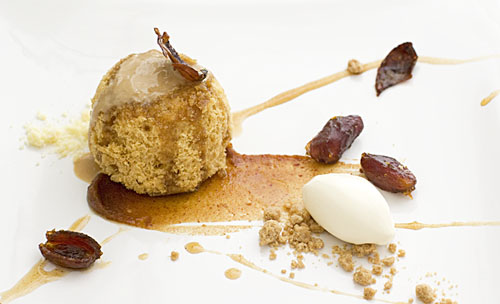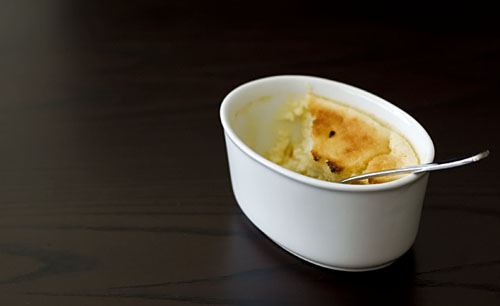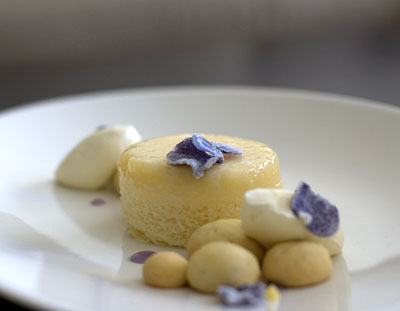Daring Bakers Challenge : Puddings

The April 2010 Daring Bakers’ challenge was hosted by Esther of The Lilac Kitchen. She challenged everyone to make a traditional British pudding using, if possible, a very traditional British ingredient: suet.
Pudding purists may want to avert their eyes now. As I was very pressed for time this month, a few shortcuts were taken in order to make the deadline for the challenge. I opted for one of the recipes provided that called for butter rather than suet, and instead of steaming the pudding (which would have taken hours), the mixture was (gasp)microwaved(gasp). It literally took one minute to cook the pudding, and rather pleasingly, it turned out gloriously fluffy and very very tasty.
The pudding was flavoured with Manuka honey – a decision brought about mainly by my wish to utilise that rather lonely jar of New Zealand’s finest honey sitting in the cupboard. The combination of the honey with a hint of vanilla and spice in the pudding, brought to mind classic sticky date pudding, hence the date and coffee puree, as well as a scattering of chestnut crumble (to complete that Autumnal touch), some poached dates and crispy date skins.
While this hasty pudding ended up being pretty tasty, I still kind of wish there had been time to attempt a traditional Sussex pond pudding or a steak and kidney pie – two things that just so happen to be on the list of things I want to try baking. Perhaps it will finally happen, when this hectic daze that I’m in calms down a little….

Meanwhile here’s another pudding I made recently when we fancied a quick and fairly healthy dessert. This wonderful Lebanese recipe is from the Moro cookbook and is incredibly easy to make. It contains only a very small amount of flour, and so can be adapted to be gluten-free as well. The pudding was so light, clean and citrussy that it practically needed no accompaniment, but if need be, I can imagine it pairing well with stewed rhubarb or berries and stonefruit.
Yogurt cake with pistachios :
(from Moro The Cookbook by Sam and Sam Clark)
3 large organic or free-range eggs, separated
70g caster sugar
2 vanilla pods, split in half lengthways
350g yogurt (home made yogurt, or Greek yogurt thinned with a little milk)
finely grated zest of 1 lemon and 1/2 orange
juice of 1 lemon
20g plain flour
30g shelled unsalted pistachio nuts, roughly chopped [I omitted these as I didn’t have any at the time]
Preheat the oven to 180’C and put a bain-marie of water in to warm on the middle shelf. Have ready a 25cm round or square baking dish or cake tin with a solid bottom, preferably stainless-steel, or lined with greaseproof paper.
In a bowl beat the egg yolks with three-quarters of the sugar until thick and pale. Scrape out the seeds from the vanilla pod and mix into the egg-sugar mixture. Add the yogurt, lemon and orange zest, lemon juice and the flour and mix well. In a separate bowl whisk up the egg whites with the remaining sugar until soft peaks form. Gently and evenly, fold the whites into the yogurt mixture. Pour the mixture into the baking tin. Place the tin in the bain-marie, making sure that the boiling water comes halfway up the tin, and cook for about 20 minutes. Then add the chopped pistachios, sprinkling them gently on top, and continue cooking for a further 20 minutes or until the top is light brown in colour. The correct consistency of the cake should be a light sponge on top with a wet custard below. Serve with yogurt.
Tags: chestnut, coffee, Daring Bakers, date, honey, plated dessert, pudding, yogurt









